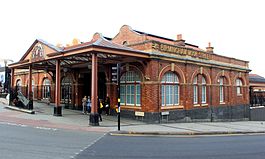Birmingham Moor Street railway station
| Birmingham Moor Street |
|
|---|---|

Restored GWR entrance to Moor Street.
|
|
| Location | |
| Place | Birmingham |
| Local authority | City of Birmingham |
| Coordinates | 52°28′44″N 1°53′35″W / 52.479°N 1.893°WCoordinates: 52°28′44″N 1°53′35″W / 52.479°N 1.893°W |
| Grid reference | SP074867 |
| Operations | |
| Station code | BMO |
| Managed by | Chiltern Railways |
| Number of platforms | 4 |
| DfT category | B |
| Live arrivals/departures, station information and onward connections from National Rail Enquiries |
|
| Annual rail passenger usage* | |
| 2011/12 |
|
| 2012/13 |
|
| 2013/14 |
|
| 2014/15 |
|
| 2015/16 |
|
| Passenger Transport Executive | |
| PTE | Transport for West Midlands |
| Zone | 1 |
| History | |
| 1909 | Opened |
| 1914 | Current buildings completed |
| 1987 | Station relocated, through platforms opened, terminal platforms closed. |
| 2002 | Renovated |
| 2010 | Two terminal platforms reopened. |
| National Rail – UK railway stations | |
| * Annual estimated passenger usage based on sales of tickets in stated financial year(s) which end or originate at Birmingham Moor Street from Office of Rail and Road statistics. Methodology may vary year on year. | |
|
|
|
Birmingham Moor Street is one of three main railway stations in the city centre of Birmingham, England, along with Birmingham New Street and Birmingham Snow Hill.
Today's Moor Street station is a combination of the original station, opened in 1909 by the Great Western Railway as a terminus for local trains, and a newer Moor Street station with through platforms, a short distance from the original, which opened in 1987, replacing the original. The two were combined into one station in 2002, when the original was reopened and restored, and the newer station rebuilt in 1930s style.
Moor Street has become more important in recent years; two of the original terminus platforms were reopened in 2010, and the station is now the terminus of many Chiltern Railways services from London Marylebone, as well as being an important stop for local services on the Snow Hill Lines. It is now the second busiest railway station in Birmingham.
At the turn of the 20th Century, suburban rail traffic into Birmingham was growing rapidly. The Great Western Railway greatly expanded their facilities in the city at that time to cope with the demands. Snow Hill station, their main station in Birmingham, was extensively rebuilt and expanded. However, the twin tracked Snow Hill tunnel, which ran underneath the city centre into Snow Hill from the south, did not have enough capacity to accommodate all of the traffic, and widening the tunnel was considered impractical. In order to solve the capacity problem therefore, Moor Street station was built at the opposite end of the tunnel to take terminating local trains from the south and relieve traffic.
It was a terminus for local trains from Leamington Spa, and local trains from Stratford-upon-Avon via the recently opened North Warwickshire Line. It was opened with temporary buildings in July 1909, the permanent buildings were completed in 1914. The station was located south of the entrance to Snow Hill tunnel, at the end of a short branch (the Moor Street branch) which connected the station to the main line, it originally had a single 700ft (213 metre) long island platform with two platform faces, a third side platform, 600ft (183 metres) long was added in 1930. The through tracks to Snow Hill running alongside however were not provided with platforms.
...
Wikipedia
